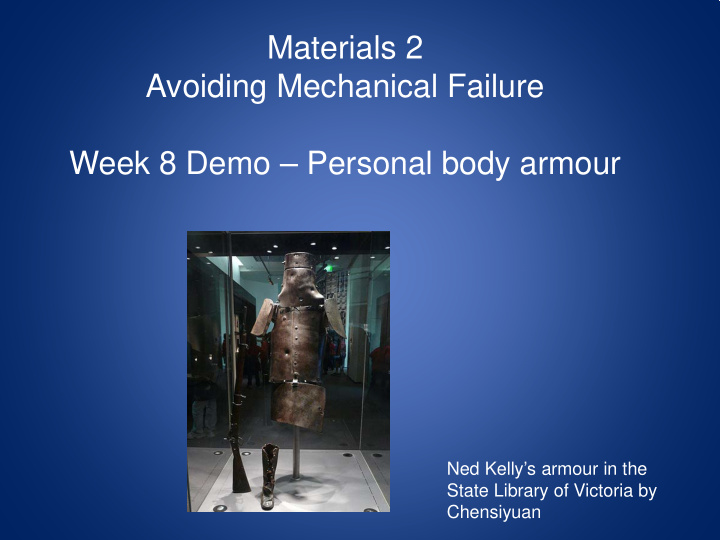



Materials 2 Avoiding Mechanical Failure Week 8 Demo – Personal body armour Ned Kelly’s armour in the State Library of Victoria by Chensiyuan
Personal armour has always been a trade-off between protection and movement Steel armour ~ 1550 Bronze armour from ~ 300BC http://en.wikipedia.org/wiki/File:Lorica_Hamata.jpg by Greatbeagle Hardened leather scale armour – samuraiantiqueworld
Assignment 2 - Need to understand the application to accurately to do the first two dot points. - If body armour was the topic – then how does it protect a person?
Need to understand what you are trying to protect against slow motion bullet impact
Some things to think about • Kinetic energy – this energy has to be dissipated before it reaches the target – either by armour penetration or through projectile deformation • Soft versus hard projectile materials • Global versus local damage to the armour
Modern materials – aramid fibre • Tensile strength in the excess of 3500 MPa • Young’s modulus ~ 130 Gpa • Often produced as a woven fabric Some things that are important Modulus and tenacity (breaking force divided by denier) of the fibre Strain wave velocity - (fibre modulus/fiber density)*1/2 Friction between fibre and fibre (and fibre and projectile). Can coat fibres to increase friction. Lightweight ballistic composites by Ashok Bhatnagar (2006)
Local versus global damage
Modern materials – hybrid armour Very common to put a hard ceramic plate with a woven fibre backing. What do you think the roles of each are?
Research literature • Where to find it • How to quickly assess it • What parts are important • What is the paper I find doesn’t give me everything I need? • Citing the right way
http://www.nature.com/ncomms/journal/v3/n10/full/ncomms2166.html
Recommend
More recommend